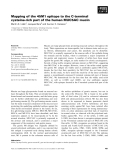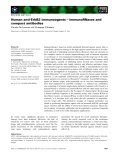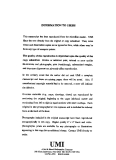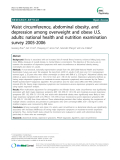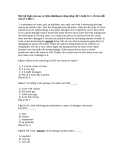
The human body
-
Slowly digestible starch is the starch fraction that is digested at a slow rate in the body, meaning it is broken down by the digestive enzyme in human body during 20 to 120 min. after eating. Recently, slowly digestible starch (SDS) and resistant starch (RS) are widely studied worldwide because of their various positive health effects: releasing glucose at a slow rate, thereby maintaining sufficient blood glucose, glycemic index and insulin levels, reducing the risk of Type II diabetes, etc...
 8p
8p  visarada
visarada
 28-04-2025
28-04-2025
 1
1
 1
1
 Download
Download
-
Anthropometry is a part of physical anthropology, a science that allows the study of measurement methods on the human body and the use of mathematics to analyze the measured results in order to find patterns about human physical development. Measurement of the human body is one of the methods of assessing the general health and nutritional status of an individual or a population.
 8p
8p  viakimichi
viakimichi
 17-01-2025
17-01-2025
 5
5
 2
2
 Download
Download
-
Human anatomy and physiology is more than just interesting, it is fascinating. To help get the students and instructions involved in the study of this subject, a number of special features are incorporated throughout the lecture note.
 428p
428p  phannguyenhaminhths
phannguyenhaminhths
 18-08-2021
18-08-2021
 26
26
 2
2
 Download
Download
-
The result of the study will be another illustration for the beauty of language, especially when it is used under the observation of cognitive semantics and metaphor. The findings of a contrastive analysis of English and Vietnamese will be a great benefit for Vietnamese learners of English. Moreover, the deep investigation will help them improve their understanding of meanings of words denoting the Names of human body parts and get better results in reading comprehension, translation work as well as in everyday language.
 13p
13p  bautroibinhyen27
bautroibinhyen27
 04-05-2017
04-05-2017
 100
100
 3
3
 Download
Download
-
This chapter provides knowledge of cell cycle. The main contents of this chapter include all of the following: List the phases of the cell cycle and describe the key events of each phase, describe the process of DNA replication.
 9p
9p  tangtuy07
tangtuy07
 02-04-2016
02-04-2016
 33
33
 2
2
 Download
Download
-
Affinity reagents capable of selective recognition of the different human immunoglobulin isotypes are important detection and purification tools in biotechnology. Here we describe the development and characterization of affinity proteins (affibodies) showing selective binding to human IgA. From protein libraries constructed by combinatorial mutagenesis of a 58-amino-acid, three-helix bundle domain derived from the IgG-binding staphylococcal protein A, variants showing IgA binding were selected by using phage display technology and IgA monoclonal antibodies (myeloma) as target molecules. ...
 9p
9p  system191
system191
 01-06-2013
01-06-2013
 44
44
 3
3
 Download
Download
-
Catalytic antibodies capable of digesting crucial proteins of pathogenic bac-teria have long been sought for potential therapeutic use. Helicobacter pyloriurease plays a crucial role for the survival of this bacterium in the highly acidic conditions of human stomach. The HpU-9 monoclonal anti-body (mAb) raised againstH. pyloriurease recognized thea-subunit of the urease, but only slightly recognized theb-subunit. However, when isolated both the light and the heavy chains of this antibody were mostly bound to the b-subunit....
 9p
9p  fptmusic
fptmusic
 11-04-2013
11-04-2013
 46
46
 3
3
 Download
Download
-
Superantigens (SAgs) are a class of disease-causing and immunostimulatory proteins of bacterial or viral origin that activate a large number of T-cells through interaction with the Vbdomain of T-cell receptors (TCRs). In this study, recombinant TCRbchains were constructed with human variable domains Vb5.2, Vb1and Vb2.1, expressed as inclusion bodies, refolded and purified. The Streptococcus pyogenesSAg SSA-1 was cloned and expressed as a soluble periplasmicprotein. SSA-1wasobtainedbothas amonomer and a dimer that has an intermolecular disulfide bond. ...
 9p
9p  awards
awards
 05-04-2013
05-04-2013
 39
39
 5
5
 Download
Download
-
Benzo[a]pyrene (B[a]P) is a common food pollutant that causes DNA adduct formation and is carcinogenic. The report of a positive correlation between human plasma B[a]P levels and body mass index, together with B[a]P’s lipophilicity, led us to test for possible adverse effects of B[a]P on adipose tissue.
 11p
11p  inspiron33
inspiron33
 26-03-2013
26-03-2013
 54
54
 5
5
 Download
Download
-
Transmissible spongiform encephalopathies are fatal neurodegenerative dis-eases that are caused by unconventional pathogens and affect the central nervous system of animals and humans. Several different forms of these dis-eases result from natural infection (i.e. exposure to transmissible spongiform encephalopathy agents or prions, present in the natural environment of the respective host).
 18p
18p  galaxyss3
galaxyss3
 21-03-2013
21-03-2013
 41
41
 3
3
 Download
Download
-
Mucins are large glycoproteins protecting mucosal surfaces throughout the body. Their expressions are tissue-specific, but in disease states such as cys-tic fibrosis, inflammation and cancer, this specificity can be disturbed. MUC5AC is normally expressed in the mucous cells of the epithelia lining the stomach and the trachea, where it constitutes a major component of the gastric and respiratory mucus.
 9p
9p  media19
media19
 05-03-2013
05-03-2013
 36
36
 2
2
 Download
Download
-
Immunotherapy, based on mAbs specifically directed against cancer cells, is considered a precious strategy in the fight against cancer because of its selec-tivity and lack of multidrug resistant effects. However, there are obstacles to the complete success of current immunotherapy such as immune responses to nonhuman or even humanized antibodies and the large size of the anti-bodies, which hinders their diffusion into bulky tumors.
 9p
9p  vinaphone15
vinaphone15
 27-02-2013
27-02-2013
 40
40
 3
3
 Download
Download
-
THE ECONOMICS OF NUTRITION, BODY BUILD, AND HEALTH: WAALER SURFACES AND PHYSICAL HUMAN CAPITAL
 210p
210p  mualan_mualan
mualan_mualan
 25-02-2013
25-02-2013
 94
94
 10
10
 Download
Download
-
the human body needs nutrients to 3 as calcium, iron and zinc in the juvenile stage. In addition to providing nutrients, the split meals a day, eat slowly and chew very positive effects help this little group of obesity and diseases related to metabolism.
 9p
9p  thulanh29
thulanh29
 17-12-2011
17-12-2011
 57
57
 4
4
 Download
Download
-
Đọc kỹ đoạn văn sau và chọn phương án đúng (ứng với A hoặc B, C, D) cho mỗi câu từ 1 đến 5. A combination of water, salt, air pollution, sun, sand, and wind is destroying the huge statue just outside Cairo. This five-thousand-year-old statue, which has the body of a lion and the face of a human being, is too badly damaged to be completely saved. First, there is not a good drainage system around the statue and too much water has been running into the stone statue for several years. As a result, tiny pieces of salt...
 9p
9p  lavie2
lavie2
 19-06-2011
19-06-2011
 144
144
 12
12
 Download
Download
-
Thuốc Benlysta (Human Genome Sciences and GlaxoSmithKline) thử nghiệm trị bệnh Lupus Scheduled for a March 10 approval, Benlysta could be the first new lupus drug developed in 50 years. It isn't a cure. Taken monthly, the intravenous drug prevents flare-ups by inhibiting B-cells found in the immune system, which in lupus patients attack the body and organs. Lupus isn't easy to treat, which explains why Benlysta has received widespread attention and why Human Genome Sciences' stock price has skyrocketed over the last two years. ...
 4p
4p  nganluong111
nganluong111
 14-04-2011
14-04-2011
 141
141
 4
4
 Download
Download
-
Meets or Exceeds TIA/EIA-232-F and ITU D D D D D D D D Recommendation V.28 Operates From a Single 5-V Power Supply With 1.0-mF Charge-Pump Capacitors Operates Up To 120 kbit/s Two Drivers and Two Receivers ±30-V Input Levels Low Supply Current . . . 8 mA Typical ESD Protection Exceeds JESD 22 − 2000-V Human-Body Model (A114-A) Upgrade With Improved ESD (15-kV HBM) and 0.1-mF Charge-Pump Capacitors is Available With the MAX202 Applications − TIA/EIA-232-F, Battery-Powered Systems, Terminals, Modems, and Computers. ...
 17p
17p  son2483
son2483
 22-10-2010
22-10-2010
 185
185
 21
21
 Download
Download
-
One of the greatest challenges to confront an artist is drawing the human figure. Our bodies are infinitely complex yet intimately familiar, giving rise to a subject that is difficult to depict accurately yet judged incessantly. The human figure is almost overwhelmingly complex for the artist to draw. The human figure is an organic structure that defies geometric simplification. It is composed of bones, muscles, and organs, all of which are covered by a flexible layer of skin. The body has many moving parts that make it almost impossible to define as a shape. Within its skeleton are more...
 16p
16p  audi123
audi123
 31-07-2010
31-07-2010
 180
180
 29
29
 Download
Download
-
p

 01-01-1970
01-01-1970


 Download
Download
CHỦ ĐỀ BẠN MUỐN TÌM










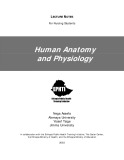

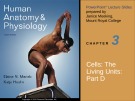
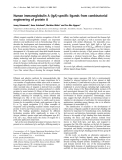
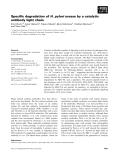
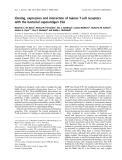
![Báo cáo khoa học: Benzo[a]pyrene impairs b-adrenergic stimulation of adipose tissue lipolysis and causes weight gain in mice A novel molecular mechanism of toxicity for a common food pollutant Báo cáo khoa học: Benzo[a]pyrene impairs b-adrenergic stimulation of adipose tissue lipolysis and causes weight gain in mice A novel molecular mechanism of toxicity for a common food pollutant](https://dev.tailieu.vn/image/document/thumbnail/2013/20130326/inspiron33/135x160/6391364373307.jpg)

